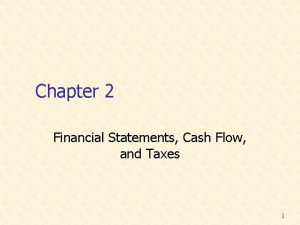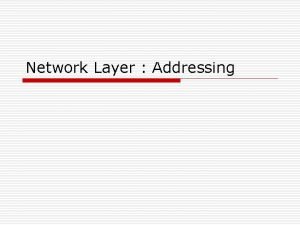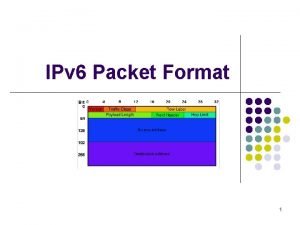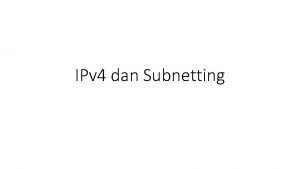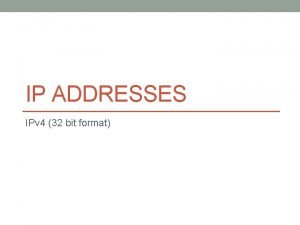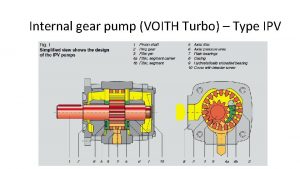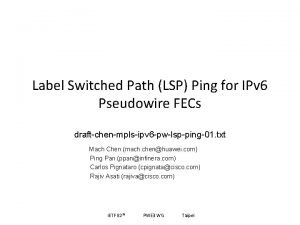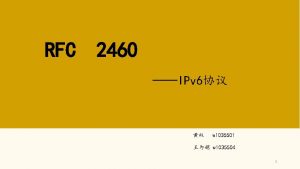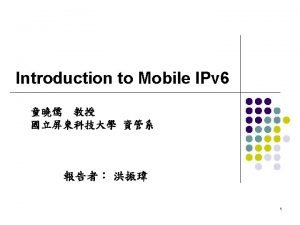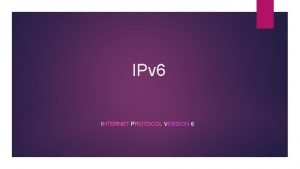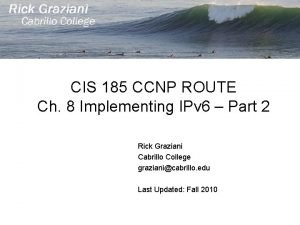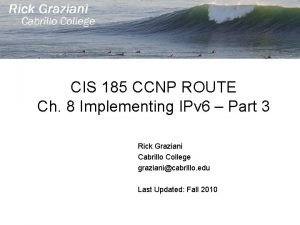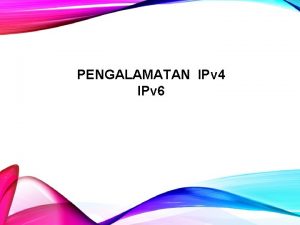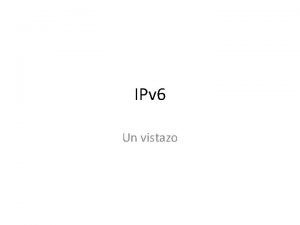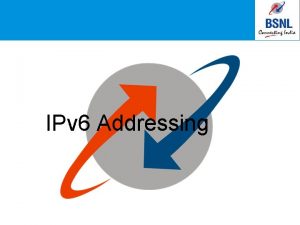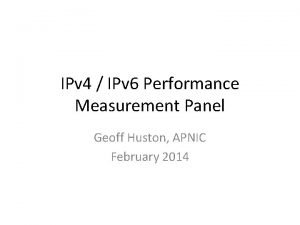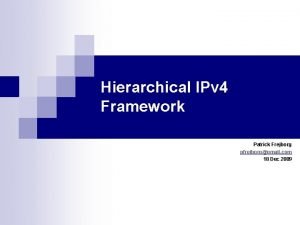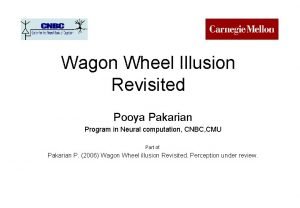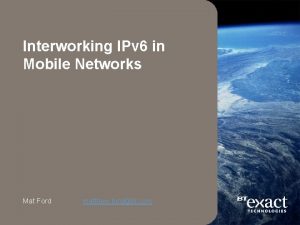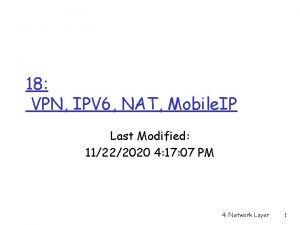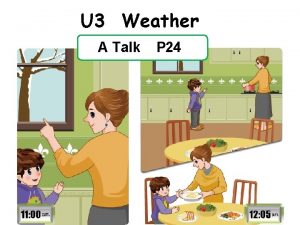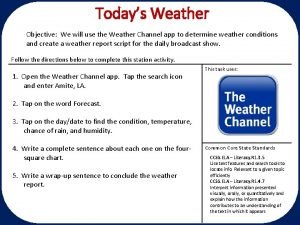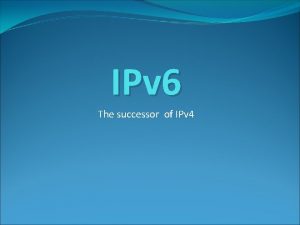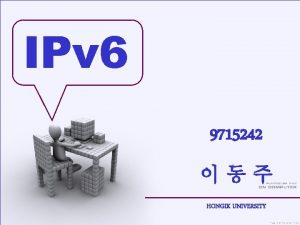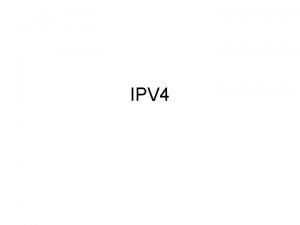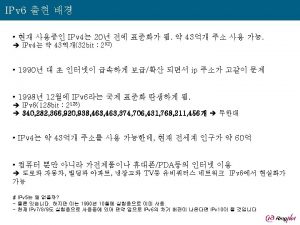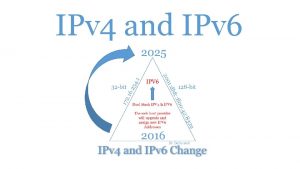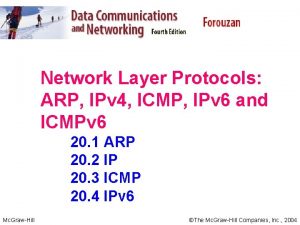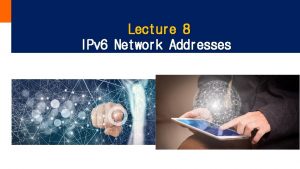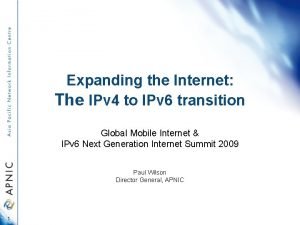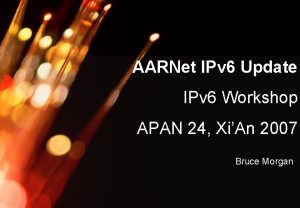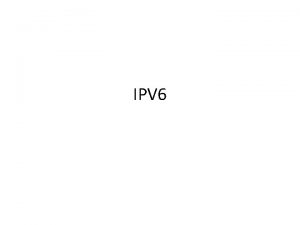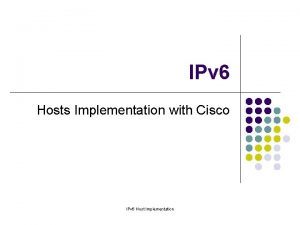6 Network Today IPv 4 Network Millions of






















































































- Slides: 86




6 I p v 技 術 理 論 與 實 務 研 習 班 Network Today IPv 4 Network (Millions of Nodes) IPv 6 Network (Thousands of Nodes) 4

6 I p v 技 術 理 論 與 實 務 研 習 班 5 Future Network IPv 4 Network (Millions of Nodes) IPv 6 Network (Trillions of Nodes)

6 I p v 技 術 理 論 與 實 務 研 習 班 6 IETF NGTrans(v 6 ops) Working Group v Define the processes by which networks can be transitioned from IPv 4 to IPv 6 v Define & specify the mandatory and optional mechanism that vendors are to implement in Hosts, Routers and other components of the Internet in order for the Transition. v http: //www. ietf. org/html. charters/ngtranscharter. html v http: //www. ietf. org/html. charters/v 6 opscharter. html

6 I p v 技 術 理 論 與 實 務 研 習 班 IPv 4 -IPv 6 Transition /Co-Existence A wide range of techniques have been identified and implemented, basically falling into three categories: – – – Dual-stack techniques, to allow IPv 4 and IPv 6 to co-exist in the same devices and networks Tunneling techniques, to avoid order dependencies when upgrading hosts, routers, or regions Translator techniques, to allow IPv 6 -only devices to communicate with IPv 4 -only devices Expect all of these to be used, in combination 7



Dual Stack v RFC 2893 v DSTM: Draft-ietf-ngtransdstm-08. txt

RFC 2893 Transition Mechanisms for IPv 6 Hosts and Routers

6 I p v 技 術 理 論 與 實 務 研 習 班 RFC 2893 Applications TCP/UDP IPV 4 Routing protocols IPV 6 TCP/UDP Device Driver IPV 4 IPV 6 Device Driver V 6 network V 4/V 6 network V 4 network 12

Draft–ietf–ngtrans–dstm– 08. txt Dual Stack Transition Mechanism (DSTM)

6 I p v 技 術 理 論 與 實 務 研 習 班 Dual Stack Transition Mechanism v What is it for? – DSTM assures communication between IPv 4 applications in IPv 6 only networks and the rest of the Internet. ? IPv 6 only 14 IPv 4 only

I p v 6 DSTM: Principles 技 術 理 論 與 實 務 研 習 班 15 v v Allows IPv 6/IPv 4 hosts to talk to IPv 4 hosts IPv 4 address not initially assigned to dual-stack host Uses a DHCPv 6 server to temporarly assign IPv 4 address; and a special DNS server Requires at least one IPv 4 address per site


6 I p v 技 術 理 論 與 實 務 研 習 班 17 大綱 簡介 v Dual Stack v Tunneling v Translator v

Tunneling v RFC 2893 v RFC 2529 v RFC 3053 v RFC 3056 v ISATAP: Draft-ietf-ngtransisatap-13. txt

RFC 2893 Transition Mechanisms for IPv 6 Hosts and Routers

I p v 6 RFC 2893 技 術 理 論 與 實 務 研 習 班 v Configured tunnels – Connects IPv 6 hosts or networks over an existing IPv 4 infrastructure – Generally used between sites exchanging traffic regularly v Automatic tunnels – Tunnel is created then removed after use – Requires IPv 4 compatible addresses 20

I p v 6 Configured Tunnels 技 術 理 論 與 實 務 研 習 班 IPv 4 Tunnel Dual-stack node IPv 6 H 21 IPv 4 Networks IPv 6 Island Payload IPv 4 H IPv 6 Island Dual-stack node Payload IPv 6 H Payload

I p v 6 Automatic Tunnel 技 術 理 論 與 實 務 研 習 班 v Node is assigned an IPv 4 compatible address – v : : 140. 112. 1. 101 If destination is an IPv 4 compatible address, automatic tunneling is used – Routing table redirects : : /96 to automatic tunnel interface 0000. . . . 0000 80 22 0000 16 IPv 4 address 32

I p v 6 Automatic Tunnel 技 術 理 論 與 實 務 研 習 班 0: 0: 0: 0 Dual-stack IPv 6 Island node IPv 4 Internet IPv 6 H 23 el n un T 4 IPv Dual-stack node Payload IPv 4 H IPv 6 H Payload IPv 4 Address

RFC 2529 6 over 4

6 I p v 技 術 理 論 與 實 務 研 習 班 6 over 4 Interconnection of isolated IPv 6 domains in an IPv 4 world v No explicit tunnels v The egress router of the IPv 6 site must v – – – Have a dual stack (IPv 4/IPv 6) Have a globally routable IPv 4 address Have an IPv 4 multicast infrastructure l – 25 Local IPv 4 multicast network appears as a single IPv 6 subnet Implement 6 over 4 on an external interface

6 I p v 技 術 理 論 與 實 務 研 習 班 How 6 over 4 works System with 6 over 4 driver System to System communication via IPv 6 over IPv 4 tunneling using IPv 4 addresses learned during Autoconfig/ND System with 6 over 4 driver 26 Autoconfiguration and ND via IPv 4 Multicast V 4/v 6 v 4 v 4 6 over 4 router V 4/v 6 v 4 V 4/v 6 Site’s IPv 4 routing infrastructure IPv 4 Multicast enabled

RFC 3053 IPv 6 Tunnel Broker

6 I p v 技 術 理 論 與 實 務 研 習 班 Motivation v IPv 6 tunneling over the internet requires heavy manual configuration – – v Network administrators are faced with overwhelming management load Getting connected to the IPv 6 world is not an easy task for IPv 6 beginners The Tunnel Broker approach is an opportunity to solve the problem – The basic idea is to provide tunnel broker servers to automatically manage tunnel requests coming from the users v Benefits – – 28 Stimulate the growth of IPv 6 interconnected hosts Allow to early IPv 6 network providers the provision of easy access to their IPv 6 networks

6 I p v 技 術 理 論 與 實 務 研 習 班 29 Tunnel broker v Tunnel broker automatically manages tunnel requests coming from the users – v v The Tunnel Broker fits well for small isolated IPv 6 sites, especially isolated IPv 6 hosts on the IPv 4 Internet Client node must be dual stack (IPv 4/IPv 6) The client IPv 4 address must be globally routable (no NAT)


RFC 3056 Connection of IPv 6 Domains via IPv 4 Clouds(6 to 4)

I p v 6 6 to 4 技 術 理 論 與 實 務 研 習 班 • Allows communication of isolated IPv 6 domains over an IPv 4 infrastructure • Minimal manual configuration • Uses globally unique prefix comprised of the unique 6 to 4 TLA and the globally unique IPv 4 address of the exit router. FP TLA V 4 address SLA ID Interface ID 001 0 x 0002 3 32 16 64 Prefix length : 48 bits TLA value : 0 x 0002 Format prefix : 001 NLA value : V 4 address

6 I p v 技 術 理 論 與 實 務 研 習 班 6 to 4 v IPv 6 addressing – – Any isolated IPv 6 domain can autonomously build its own globally unique IPv 6 prefix. The globally unique IPv 4 address of the domain border router is used for this purpose. Public IPv 4 address of dual-stack GW 6 to 4 prefix ISPv 4 assigned managed IPv 4 SLA 2002 internet Router 4/6 IPv 6 island 33 Well known 0 x 2002 auto-configured Interface ID

6 I p v 技 術 理 論 與 實 務 研 習 班 6 to 4 v Communication among 6 to 4 sites – – v The egress router automatically creates a tunnel to the destination domain The IPv 4 endpoint is extracted from the destination IPv 6 prefix Only the egress router has to be 6 to 4 capable. internet Router 6 to 4 34 6 to 4 site tunnel Router 6 to 4 site

6 I p v 技 術 理 論 與 實 務 研 習 班 6 to 4 v Communication with the native IPv 6 world – – Based on 6 to 4 relays A 6 to 4 router must be able to locate at least one 6 to 4 relay (e. g. manual conf. ) ISP internet ISP site 2002: : /16 Router 6 to 4 35 tunnel Router 6 to 4

Draft-ietf-ngtrans-isatap-13. txt Intra-Site Automatic Tunnel Addressing Protocol (ISATAP)

6 I p v 技 術 理 論 與 實 務 研 習 班 ISATAP v v The primary function of ISATAP is to allow hosts that are multiple IPv 4 hops away from an IPv 6 router to participate in the IPv 6 network by automatically tunneling IPv 6 packets over IPv 4 to the next-hop address. Example: ISATAP host communicates with IPv 6 host (no ISATAP support). – The ISATAP host is isolated in an IPv 4 network whereas the IPv 6 host is a IPv 6 network IPv 6 HOST B IPv 4 Infrastructure ISATAP Supported 37 ISATAP IPv 6 Network

6 I p v 技 術 理 論 與 實 務 研 習 班 ISATAP v In the reverse direction, the ISATAP router automatically performs IPv 6 in-IPv 4 tunneling for packets from the native IPv 6 host to the ISATAP host even though the native IPv 6 host has no knowledge of the legacy IPv 4 infrastructure or addressing architecture. IPv 6 HOST B IPv 4 Infrastructure ISATAP Supported 38 ISATAP IPv 6 Network

I p v 6 Construction of ISATAP address 技 術 理 論 與 實 務 研 習 班 v v ISATAP interface identifier can be combined with any 64 -bit prefix (including 6 to 4 prefixes) to form an RFC 2373 compliant IPv 6 globally aggregatable unicast address. IPv 4 address inside EUI-64 interface identifier : : 0: 5 EFE: A. B. C. D for IPv 4 address A. B. C. D The 0: 5 EFE portion is formed from the combination of the Oganizational Unit Identifier (OUI) that is assigned to IANA, and a type that indicates an embedded IPv 4 address (FE). ISATAP Prefix 39 Specially constructed EUI 64 Interface ID Interface Identifier 64 -bits ISATAP Address Format

I p v 6 ISATAP Address Example 技 術 理 論 與 實 務 研 習 班 EUI-64 Format Interface Identifier 00 00 24 -bits OUI 5 e TYPE TSD 40 -bits Extension ID v If TYPE = 0 x. FF and TSE = 0 x. FE, TSD contains legacy EUI 48 (TSE = 0 x. FF reserved by IEEE). v If TYPE = 0 x. FE, TSE and TSD together contain embedded IPv 4 address is: 140. 173. 129. 3 routing prefix is: 3 FFE: 1 A 05: 510: 2412 Specially constructed EUI 64 Interface ID ISATAP IPv 6 address is: 3 FFE: 1 A 05: 510: 2412 : 0: 5 EFE: 140. 173. 129. 3 40 40 Link-local variant is: FE 80: : 0: 5 EFE: 140. 173. 129. 3

6 I p v 技 術 理 論 與 實 務 研 習 班 ISATAP Operation Simple Deployment Scenario of ISATAP (Hosts…. ) The Automatic Tunneling Pseudo-Interface uses the link-local ISATAP address assigned to the interface as a source, and uses the last 32 bits in the source and destination IPv 6 addresses (corresponding to the embedded IPv 4 addresses) as the source and destination IPv 4 addresses 10. 40. 1. 29 IPv 4 Infrastructure FE 80: 5 EFE: 10. 40. 1. 29 IPv 6 Header IPv 6 Data HOST A ISATAP Supported Src = FE 80: 5 EFE: 10. 40. 1. 29 Dst = FE 80: 5 EFE: 192. 168. 41. 30 41 41 192. 168. 41. 30 FE 80: 5 EFE: 192. 168. 41. 30 HOST B IPv 4 Header IPv 6 Data Src = 10. 40. 1. 29 Dst = 192. 68. 41. 30 ISATAP Supported IPv 6 Header IPv 6 Data Src = FE 80: 5 EFE: 10. 40. 1. 29 Dst = FE 80: 5 EFE: 192. 168. 41. 30

I p v 6 ISATAP Operation 技 術 理 論 與 實 務 研 習 班 Simple Deployment Scenario of ISATAP (Routers…) IPv 6 Network IPv 6 HOST IPv 6 Header IPv 6 Data ISATAP HOST ISATAP IPv 6 in IPv 4 Network 192. 168. 41. 25 3 FFE: 1 A 05: 5102412: 5 EFE: 192. 168. 41. 25 10. 40. 1. 29 3 FFE: 1 A 05: 5102412: 5 EFE: 10. 40. 1. 29 IPv 6 IPv 4 IPv 6 Header Data IPv 6 Src = 10. 40. 1. 29 Header Data Dst = 192. 68. 41. 25 Src = 3 FFE: 1 A 05: 5102412: 5 EFE: 10. 40. 1. 29 Dst = 3 FFE: 3600: 8: : 1 Next = 3 FFE: 1 A 05: 5102412: 5 EFE: 192. 168. 41. 25 42 42 Dst = 3 FFE: 3600: 8: : 1

6 I p v 技 術 理 論 與 實 務 研 習 班 43 大綱 簡介 v Dual Stack v Tunneling v Translator v

Translator v. RFC 2765 v. RFC 2766 v. RFC 2767 v. RFC 3338 v. RFC 3089 v. RFC 3142

RFC 2765 Stateless IP/ICMP Tanslation algorithm (SIIT)


6 I p v 技 術 理 論 與 實 務 研 習 班 SIIT § § 47 § Allows IPv 6 -only hosts to talk to IPv 4 hosts Translation on IP packet header (including ICMP headers) in separate translator boxes in the network without requiring any per-connection state in those boxes. Use IPv 4 -translatable IPv 6 address (0: : ffff: 0: a. b. c. d) Most option fields can not be translated Requires one temporary IPv 4 address per


RFC 2766 Network Address Translation – Protocol Translation (NAT-PT)

6 I p v 技 術 理 論 與 實 務 研 習 班 50 Introduction p. Allows IPv 6 -only hosts to talk to IPv 4 hosts and viceversa p. Stateful translation p. Requires at least one IPv 4 address per site p. Traditional NAT-PT m. Sessions are unidirectional, outbound from the v 6 network m. Two variations: Basic-NAT-PT and NAPT-PT p. Bi-directional-NAT-PT m. Session can be initiated from hosts in v 4 network as well as the v 6 network m. A DNS-ALG must be employed to facilitate name to address mapping psimilar to NAT in IPv 4 network

I p v 6 Limitations 技 術 理 論 與 實 務 研 習 班 § § 51 all requests and responses pertaining to session should be routed via the same NATPT router. A number of IPv 4 fields have changed meaning in IPv 6 and translation is not straightforward. Ex. Option headers, details found in [SIIT] Applications that carry the IP address in the high layer will not work. In this case ALG need to be incorporated to provide support

I p v 6 Address Translation (IPv 4 -> IPv 6) 技 術 理 論 與 實 IPv 4 務 研 習 班 DA: 2001: 230: : 2 SA: aaaa: : 129. 254. 15 DA: 132. 146. 134. 184 SA: 129. 254. 15 DNS(v 4) 129. 254. 15 DNS response resource data(132. 146. 134. 180) resource data (2001: 230: : 1) TRANSLATOR prefix aaaa: : /96 IPv 6 v 6. opicom. co. kr ? DA: 132. 146. 134. 180 SA: 129. 254. 165. 141 DA is changed to mappied address SA is added and removed prefix/96 v 4. etri. re. kr 129. 254. 165. 141 132. 146. 134. 184 DA: 2001: 230: : 1 SA: aaaa: : 129. 254. 165. 141 v 6. opicom. co. kr 2001: 230: : 1 2001: 230: : 2 DNS static Mapping 132. 146. 134. 180 0001 132. 146. 134. 181 0002 132. 146. 134. 180 2001: 230: : 1 Mapping table POOL of IPv 4 ADDRESS 52 DNS(v 6) 2001: 230: : 2 After mapping is verified either it is existed or not, DNS-ALG makes the mapping table of IPv 4 inside resource data

I p v 6 Address Translation (IPv 6 -> IPv 4) 技 術 理 論 與 實 IPv 4 務 研 習 班 DA: 129. 254. 15 SA: 132. 146. 134. 184 DNS(v 4) 129. 254. 15 resource data (129. 254. 165. 141) DA: aaaa: : 129. 254. 15 SA: 2001: 230: : 2 TRANSLATOR prefix aaaa: : /96 resource data (aaaa: : 129. 254. 165. 141) IPv 6 v 4. etri. re. kr ? DA: 129. 254. 165. 141 SA: 132. 146. 134. 180 SA is changed to mappied address DA is added and removed prefix/96 v 4. etri. re. kr 129. 254. 165. 141 132. 146. 134. 184 DA: aaaa: : 129. 254. 165. 141 SA: 2001: 230: : 1 v 6. opicom. co. kr 2001: 230: : 1 2001: 230: : 2 DNS static Mapping 132. 146. 134. 180 132. 146. 134. 181 0002 132. 146. 134. 180 2001: 230: : 1 Mapping table POOL of IPv 4 ADDRESS 53 DNS(v 6) 2001: 230: : 2 After mapping is verified either it is existed or not, NAT-PT makes the mapping table of IPv 6 source address

RFC 2767 Dual Stack Hosts using the “Bump-In-the-Stack” Technique (BIS)

6 I p v BIS 技 § Allow existing IPv 4 applications communicate 術 理 with other IPv 6 hosts (There are few applications 論 for IPv 6) 與 §Make hosts as if dual stack with applications for both 實 務 IPv 4 and IPv 6 研 習 § BIS adds new modules to the local IPv 4 stack 班 § On the BIS host, the IPv 6 destination address is mapped into a local private IPv 4 address § Same limitation as Protocol translation(SIIT): overhead/limitations of SIIT 55 § 2 layer interface dependant

6 I p v 技 術 理 論 與 實 務 研 習 班 Structure of the proposed dual stack host IPv 4 applications TCP/IPv 4 Extension name resolver Network card drivers Network card 56 Address mapper translator IPv 6

6 I p v 技 術 理 論 與 實 務 研 習 班 Action of the Originator DNS Server IPv 4 Application 2. A record IPv 4 R 3. A/AAAA record R: extension name resolver M: address mapper T: translator M T IPv 6 Network Driver 57 1. When initialization, register its own IPv 4/IPv 6 address into table 2. IPv 4 application summits a query for A record 3. Extension name resolver snoops the query, and creates another query for both A and AAAA record

6 I p v 技 術 理 論 與 實 務 研 習 班 Action of the Originator DNS Server R: extension name resolver M: address mapper T: translator IPv 4 Application 5 a. IPv 4 4 a. A record R M T IPv 6 IPv 4 Network Driver 6 a. Data 4 a. And 5 a. If A record is replied => resolver returns the A record to the Application 6 a. No need for the IP conversion by the translator 58

6 I p v 技 術 理 論 與 實 務 研 習 班 59 Action of the Originator DNS Server IPv 4 Application 7 b. IPv 4 6. b 4 b. AAAA record R: extension name resolver M: address mapper T: translator R 5 b. M T 8 b. IPv 6 Network Driver IPv 6 4 b. And 5 b. and 6 b. If AAAA record is replied, resolver requests the mapper to assign an IPv 4 address corresponding to IPv 6 address 7 b. Resolver return A record to application 8 b. Application sends IPv 4 packets to IPv 6 hosts through translator. The translator querys the mapper to provide IPv 6 addresses

6 I p v 技 術 理 論 與 實 務 研 習 班 60 Action of the recipient IPv 4 Application R IPv 4 2. M 4. T 1. IPv 6 Network Driver IPv 6 1. IPv 6 packet reaches translator 2. Translator requests mapper to provide mapping entries 3. Mapper checks the table to find the IPv 4 address for the src If no entry, mapper selects an IPv 4 address from the pool 4. Mapper returns IPv 4 source/dest address to the translator

6 I p v 技 術 理 論 與 實 務 研 習 班 Action of the recipient IPv 4 Application 5. IPv 4 R M T IPv 6 Network Driver IPv 6 5. Translator translates the IPv 6 packet into an IPv 4 packet and tosses it up to the application 61

RFC 3338 Dual Stack Hosts Using “Bump-in-the-API(BIA)”

6 I p v 技 術 理 論 與 實 務 研 習 班 63 BIA (Bump-in-the-API) v Allow existing IPv 4 applications communicate with other IPv 6 hosts (There are few applications for IPv 6) v Socket API level translation rather than the IP level translation – No overhead for protocol translation v 2 layer interface independent v Dual stack: IPv 6 application available also!

6 I p v 技 術 理 論 與 實 務 研 習 班 BIA IPv 4 applications Socket API (IPv 4, IPv 6) API Translator Name Resolver TCP(UDP)/IPv 4 64 Address Mapper Function Mapper TCP(UDP)/IPv 6

6 I p v 技 術 理 論 與 實 務 研 習 班 BIA IPv 4 applications IPv 6 applications Socket API (IPv 4) Socket API (IPv 6) API Translator (IPv 4 <-> IPv 6) TCP(UDP)/IPv 4 65 TCP(UDP)/IPv 6 IPv 4 applications Socket API (IPv 4) IPv 6 applications Socket API (IPv 6) API Translator (IPv 4 <-> IPv 6) TCP(UDP)/IPv 4 TCP(UDP)/IPv 6

RFC 3089 A SOCKS-based IPv 6/IPv 4 Gateway Mechanism

I p v 6 SOCKS gateway 技 術 理 論 與 實 務 研 習 班 v SOCKS server relays two "terminated" IPv 4 and IPv 6 connections at the "application layer" – – – v Application proxy – 67 Each socksified application has its own *Socks Lib*. replace applications' socket APIs and DNS name resolving APIs an enhanced SOCKS server that enables any types of protocol combination relays between Client C (IPv. X) and Destination D (IPv. Y). Clients must be “socksified”


6 I p v 技 術 理 論 與 實 務 研 習 班 69 Advanced SOCKS-based Gateway

RFC 3142 An IPv 6 -to-IPv 4 Transport Relay Translator

I p v 6 Transport Relay 技 術 理 論 與 實 務 研 習 班 71 v Translator – – – v At the transport level Between the IPv 6 host and IPv 4 host Receives the IPv 6 TCP connection from the origination node Makes an IPv 4 TCP connection to the destination node

6 I p v 技 術 理 論 與 實 務 研 習 班 IPv 6 -to-IPv 4 transport relay translator TRT system – dummy prefix Inner network A 6 outer network fec 0: 0: 0: 1: : /64 fec 0: 0: 0: 1: : 10. 1. 1. 1 B 6 Y 4 10. 1. 1. 1 TCP/IPv 6: the initiating host --> the TRT system address on IPv 6 header: A 6 -> C 6: : X 4 TCP/IPv 4: the TRT system --> the destination host 72 Destination host IPv 4 only Initiating host IPv 6 only X 4 address on IPv 4 header: Y 4 -> X 4 10. 1. 1. 1

I p v 6 Implementers 技 術 理 論 與 實 務 研 習 班 v In a large site, it is possible to have multiple TRT systems in a site. By the following steps: – – – Configure multiple TRT systems Configure different dummy prefix to them Let the initiating host pick a dummy prefix randomly for load-balancing l Install special DNS server to the site Configure DNS servers differently to return different dummy prefixes and tell initiating hosts of different DNS servers – Let DNS server pick a dummy prefix randomly for load-balancing. – 73

6 I p v 技 術 理 論 與 實 務 研 習 班 74 Advantages of TRT is designed to require no extra modification on IPv 6 -only initiating hosts, nor that on IPv 4 -only destination hosts. v Some other translation mechanisms need extra modifications on IPv 6 -only initiating hosts, limiting possibility of deployment. v The IPv 6 -to-IPv 4 header converters have to take care of path MTU and fragmentation issues. However, TRT is free from this problem. v

6 I p v 技 術 理 論 與 實 務 研 習 班 75 Disadvantages of TRT supports bi-directional traffic only. The IPv 6 -to. IPv 4 header converters may be able to support other cases, such as unidirectional multicast datagrams. v TRT needs a stateful TRT system between the communicating peers, just like NAT systems. It is possible to place multiple TRT systems in a site, a transport layer connection goes through particular, a single TRT system. v

6 I p v 技 術 理 論 與 實 務 研 習 班 76 Disadvantages of TRT v Special code is necessary to relay NAT-unfriendly protocols. Some of NAT-unfriendly protocols, including IPSec, cannot be used across TRT system.

Application Layer Gateway v. DNS ALG v. FTP ALG





6 I p v 技 術 理 論 與 實 務 研 習 班 82 FTP-ALG Support FTP control message 中會攜帶IP address 以及TCP port 資 訊,FTP-ALG 可以支援NAT-PT 使得FTP在application level 的轉換沒有問題。在RFC 2428中建議利用EPRT和EPSV兩個 指令分別替代PORT和PASV 指令。

6 I p v FTP-ALG Support 技 術 由V 4 node 產生FTP session 的情況 理 論 V 4 node 可能有implement EPRT 和EPSV 也可能沒有。如果 與 V 4 node 利用PORT 和PASV 送出FTPSession Request 的話, 實 FTP-ALG 會將指令分別轉換成EPRT 和EPSV。 務 研 習 班 83

I p v 6 FTP-ALG Support 技 術 理 論 與 實 務 研 習 班 84 由V 6 node 產生FTP session 的情況 q q 第一種方法:FTP-ALG 不改變EPRT 和EPSV,而只是轉換 <net-prt><net-addr><tcp-port>成NAT-PT 或NAPT-PT 所指 定的IPv 4 相對應資訊。但在這種方法下,IPv 4 端的FTP application 必須upgrade to support EPRT and EPSV。 第二種方法: FTP-ALG 把EPRT 和EPSV 分別轉換成PORT 和PASV。同時也對<net-prt><net-addr><tcp-port>這幾個參 數做轉換。好處是IPv 4 端的FTP 不需upgrade。壞處是, FTP-ALG 無法對EPSV<space>ALL 這個指令做對應的轉 換,這個情況下,IPv 4 端的FTP app 會傳回error。

I p v 6 結論:Internet Transition Trend 技 術 理 論 與 實 務 研 習 班 Only IPv 4 Ocean TB 6 to 4 6 over 4 NAT-PT IPv 6 Islan d 85 IPv 4 Ocean Multi mechanism IPv 6 Ocean IPv 4 Island NAT-PT DSTM 4 to 6 IPv 6 Ocean

 For today's meeting
For today's meeting We are going today
We are going today Meeting objective
Meeting objective Today lesson or today's lesson
Today lesson or today's lesson Today's lesson or today lesson
Today's lesson or today lesson Today's lesson or today lesson
Today's lesson or today lesson Financial statement in millions
Financial statement in millions Qui veut gagner des millions 50/50
Qui veut gagner des millions 50/50 Millions billions trillions chart
Millions billions trillions chart Apatosaurus herbivore carnivore
Apatosaurus herbivore carnivore The stars there are millions of stars in the sky
The stars there are millions of stars in the sky Paid drawing. it be work millions.
Paid drawing. it be work millions. Drawing. could be work millions.
Drawing. could be work millions. The scatterplot shows the payroll (in millions of dollars)
The scatterplot shows the payroll (in millions of dollars) Europe population in millions
Europe population in millions People laughing
People laughing Speciation can only be observed over millions of years
Speciation can only be observed over millions of years Qui veut gagner des millions
Qui veut gagner des millions Ken renard
Ken renard Ipv 4 terdiri dari... *
Ipv 4 terdiri dari... * 6 packet
6 packet Ipv 4 terdiri dari...
Ipv 4 terdiri dari... Ipv bits
Ipv bits Fa voith
Fa voith ۰میکنی
۰میکنی Ipv meaning
Ipv meaning Ipv foo
Ipv foo Portalipv
Portalipv Ping ipv
Ping ipv Kuiz ujian buaya
Kuiz ujian buaya Ipv 4 terdiri dari... *
Ipv 4 terdiri dari... * Ipv protocol
Ipv protocol 1035504
1035504 Hans tolzin wikipedia
Hans tolzin wikipedia Ipv route
Ipv route Ipv v4
Ipv v4 Ipv 6
Ipv 6 Route-map ipv
Route-map ipv Ipv refresher course
Ipv refresher course Hash trie
Hash trie Gt ipv
Gt ipv Ipv format
Ipv format Ipv format
Ipv format Ipv finance
Ipv finance Ipv route
Ipv route Ipv to psd
Ipv to psd Ipv
Ipv Ipv format
Ipv format Ipv
Ipv Ipv erfahrungen
Ipv erfahrungen Ipv header
Ipv header Ipv
Ipv Vaccine dose schedule
Vaccine dose schedule Ipv allianz
Ipv allianz Frejborg loka
Frejborg loka Wagon wheel illusion
Wagon wheel illusion Cuando se creo
Cuando se creo Test ipv que mide
Test ipv que mide Ipv streaming
Ipv streaming Wwwin.cisco.com
Wwwin.cisco.com Ipv
Ipv Classful subnetting
Classful subnetting Ipv vpn
Ipv vpn Virtual circuit approach
Virtual circuit approach Topology in computer
Topology in computer Features of peer to peer network and client server network
Features of peer to peer network and client server network Network systems design using network processors
Network systems design using network processors Network centric computing and network centric content
Network centric computing and network centric content Packet switched network vs circuit switched network
Packet switched network vs circuit switched network Gorlach circle model of english
Gorlach circle model of english Who is absent
Who is absent Which blob are you today
Which blob are you today You finish your homework last night
You finish your homework last night What the weather like today
What the weather like today Animal planet today schedule
Animal planet today schedule She's beautiful isn't she
She's beautiful isn't she Thank you ladies
Thank you ladies Today weather
Today weather Introduction of romeo and juliet
Introduction of romeo and juliet Tragic love an introduction to romeo and juliet notes
Tragic love an introduction to romeo and juliet notes The world today part 1
The world today part 1 Weather report script today
Weather report script today Todays goal
Todays goal How many years is 1260 days
How many years is 1260 days Original mark z.com
Original mark z.com Who are the nicolaitans today
Who are the nicolaitans today Take charge today the fundamentals of investing
Take charge today the fundamentals of investing






